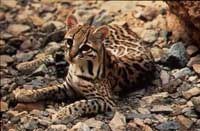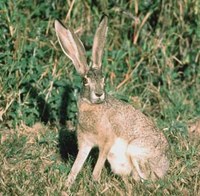South Texas Plains Wildlife

Wildlife in South Texas
Wildlife includes ocelots, the Texas tortoise, jackrabbits, javelinas, the horned lizard and green jays.

Spotted ocelots are rare, but small numbers of them still live in the thick brushy country and woodlands of the Rio Grande Valley. They slink quietly through the brush making them difficult to observe. The thick, dense brush provides protective cover for dens of young ocelot kittens. The number of ocelots has diminished due to the growth of cities and farms that have shrunk their natural habitat. Probably less than 100 ocelots remain in this region. They primarily eat rats, mice, rabbits, snakes, and birds. Fully-grown ocelots weigh between 16 to 25 pounds.

The Texas tortoise is a protected species. Their numbers have dwindled due to environmental factors and their popularity as pets. This reptile can live up to about 60 years of age and its shell length is normally 8 and a half inches as an adult. These gentle creatures are primarily vegetarians and particularly like the fruit of the prickly pear cactus. Their shells are covered by small yellowish-orange colored plates that have a peak or “horn.” Their legs are straight and strong, like columns.
 The jackrabbits is actually a member of the hare family. It has long ears, typical of a hare, and dark buff colored fur with a black stripe down its rump to the tip of its tail. Jackrabbits are always on the alert for predators, such as hawks, coyotes, and badgers. As far as eating habits go, it is strictly a vegetarian. Being active and hunting for food during the night, keeps the jackrabbit safe from predators. They can live as long as eight years in the wild.
The jackrabbits is actually a member of the hare family. It has long ears, typical of a hare, and dark buff colored fur with a black stripe down its rump to the tip of its tail. Jackrabbits are always on the alert for predators, such as hawks, coyotes, and badgers. As far as eating habits go, it is strictly a vegetarian. Being active and hunting for food during the night, keeps the jackrabbit safe from predators. They can live as long as eight years in the wild.
 The Texas Horned Lizard is a reptile that likes to bask in the sun during the morning hours but retreats to shady areas during the hottest hours of the afternoon. It is a fierce looking creature covered with horns or spikes, including two very prominent horns on its head. It is brownish in color. Contrary to its fierce look, this lizard actually has a gentle nature! They spend the day eating ants, sunbathing, and running from predators. One defensive reaction of this lizard is to puff out its body, hiss, and squirt blood from its eyes to scare away predators!
The Texas Horned Lizard is a reptile that likes to bask in the sun during the morning hours but retreats to shady areas during the hottest hours of the afternoon. It is a fierce looking creature covered with horns or spikes, including two very prominent horns on its head. It is brownish in color. Contrary to its fierce look, this lizard actually has a gentle nature! They spend the day eating ants, sunbathing, and running from predators. One defensive reaction of this lizard is to puff out its body, hiss, and squirt blood from its eyes to scare away predators!
 The javelina, or peccary, is related to the wild hog. The javelinas living in this south Texas region are the collared peccary species. They have a blackish-gray coat with a ring or “collar” of gray hair. When this animal is excited or disturbed, it gives off a strong musky odor from a special gland in front of its tail. This is why the animal is sometimes called a “musk hog.” Javelinas travel in groups or bands. They grow to be about 21 inches high. They mostly eat small animals. An interesting fact is that female javelinas usually give birth to twins!
The javelina, or peccary, is related to the wild hog. The javelinas living in this south Texas region are the collared peccary species. They have a blackish-gray coat with a ring or “collar” of gray hair. When this animal is excited or disturbed, it gives off a strong musky odor from a special gland in front of its tail. This is why the animal is sometimes called a “musk hog.” Javelinas travel in groups or bands. They grow to be about 21 inches high. They mostly eat small animals. An interesting fact is that female javelinas usually give birth to twins!
 The green jay is smaller than a crow. Its scientific name is “yncas,” an alternative spelling for “Incas,” because the first recorded description of this bird was made in Peru, where the Incan people live. The lower Rio Grande Valley is the only place in the United States where this beautiful bird can be found. It has vivid tropical colors. The green jay’s back is an olive green, changing to yellowish-green below and yellow outer feathers. Its head is bright blue with black markings and black under its throat. The beak and feet are also black. Both male and female have the same coloring. This species lives in family groups. Green jays eat insects, fruits, and seeds.
The green jay is smaller than a crow. Its scientific name is “yncas,” an alternative spelling for “Incas,” because the first recorded description of this bird was made in Peru, where the Incan people live. The lower Rio Grande Valley is the only place in the United States where this beautiful bird can be found. It has vivid tropical colors. The green jay’s back is an olive green, changing to yellowish-green below and yellow outer feathers. Its head is bright blue with black markings and black under its throat. The beak and feet are also black. Both male and female have the same coloring. This species lives in family groups. Green jays eat insects, fruits, and seeds.